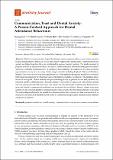Files in this item
Communication, trust and dental anxiety : a person-centred approach for dental attendance behaviours
Item metadata
| dc.contributor.author | Yuan, Siyang | |
| dc.contributor.author | Freeman, Ruth | |
| dc.contributor.author | Hill, Kirsty | |
| dc.contributor.author | Newton, Tim | |
| dc.contributor.author | Humphris, Gerry | |
| dc.date.accessioned | 2020-10-16T16:30:06Z | |
| dc.date.available | 2020-10-16T16:30:06Z | |
| dc.date.issued | 2020-10-13 | |
| dc.identifier | 270683489 | |
| dc.identifier | a37b577d-429a-45d7-ade3-d726a35c1fa3 | |
| dc.identifier | 000697665300011 | |
| dc.identifier | 85107498217 | |
| dc.identifier.citation | Yuan , S , Freeman , R , Hill , K , Newton , T & Humphris , G 2020 , ' Communication, trust and dental anxiety : a person-centred approach for dental attendance behaviours ' , Dentistry Journal , vol. 8 , no. 4 , 118 . https://doi.org/10.3390/dj8040118 | en |
| dc.identifier.issn | 2304-6767 | |
| dc.identifier.other | ORCID: /0000-0002-4601-8834/work/82179445 | |
| dc.identifier.uri | https://hdl.handle.net/10023/20794 | |
| dc.description.abstract | Effective communication forges the dentist-patient treatment alliance and is thus essential for providing person-centred care. Social rank theory suggests that shame, trust, communication and anxiety are linked together, they are moderated by socio-economic position. The study is aimed to propose and test an explanatory model to predict dental attendance behaviours using person-centred and socio-economic position factors. A secondary data analysis was conducted on a cross-sectional representative survey of a two-stage cluster sample of adults including England, Wales and Northern Ireland. Data were drawn from structured interview. Path analysis of proposed model was calculated following measurement development and confirmation of reliable constructs. The findings show model fit was good. Dental anxiety was predicted negatively by patient’s trust and positively by reported dentist communication. Patient’s shame was positively associated with dental anxiety, whereas self-reported dental attendance was negatively associated with dental anxiety. Both patient’s trust and dentist’s communication effects were moderated by social class. Manual classes were most sensitive to the reported dentist’s communications. Some evidence for the proposed model was found. The relationships reflected in the model were illuminated further when social class was introduced as moderator and indicated dentists should attend to communication processes carefully across different categories of patients. | |
| dc.format.extent | 11 | |
| dc.format.extent | 436131 | |
| dc.language.iso | eng | |
| dc.relation.ispartof | Dentistry Journal | en |
| dc.subject | Person-centered care | en |
| dc.subject | Dental anxiety | en |
| dc.subject | Communication | en |
| dc.subject | Trust | en |
| dc.subject | Socio-economic status | en |
| dc.subject | Shame | en |
| dc.subject | RK Dentistry | en |
| dc.subject | NDAS | en |
| dc.subject.lcc | RK | en |
| dc.title | Communication, trust and dental anxiety : a person-centred approach for dental attendance behaviours | en |
| dc.type | Journal article | en |
| dc.contributor.institution | University of St Andrews. Sir James Mackenzie Institute for Early Diagnosis | en |
| dc.contributor.institution | University of St Andrews. Population and Behavioural Science Division | en |
| dc.contributor.institution | University of St Andrews. WHO Collaborating Centre for International Child & Adolescent Health Policy | en |
| dc.contributor.institution | University of St Andrews. Health Psychology | en |
| dc.contributor.institution | University of St Andrews. St Andrews Sustainability Institute | en |
| dc.contributor.institution | University of St Andrews. School of Medicine | en |
| dc.identifier.doi | https://doi.org/10.3390/dj8040118 | |
| dc.description.status | Peer reviewed | en |
This item appears in the following Collection(s)
Items in the St Andrews Research Repository are protected by copyright, with all rights reserved, unless otherwise indicated.

